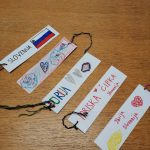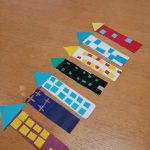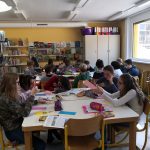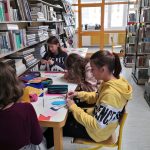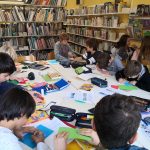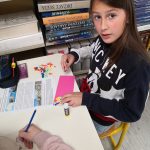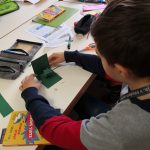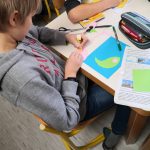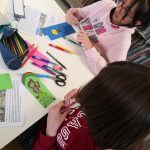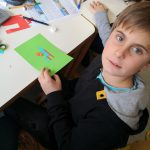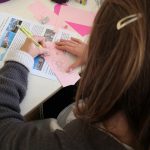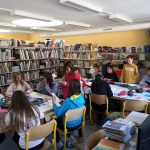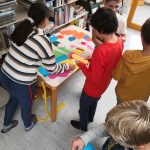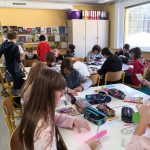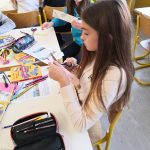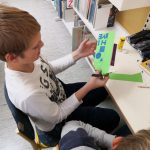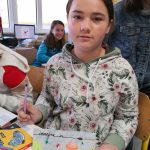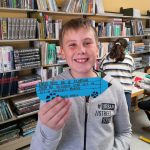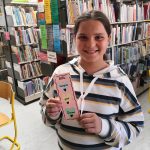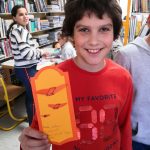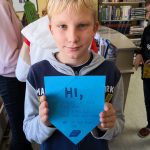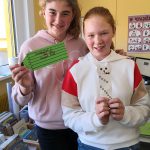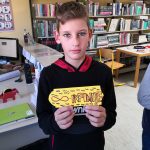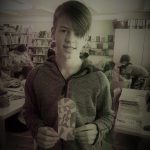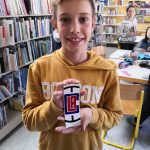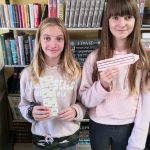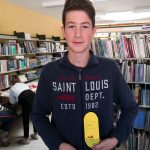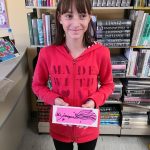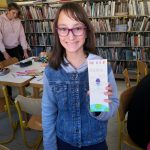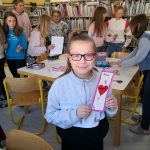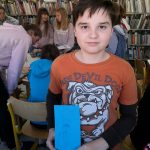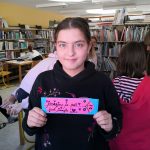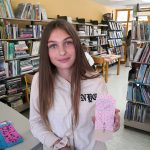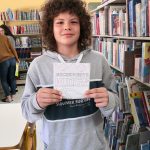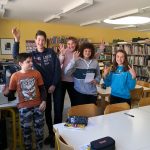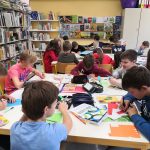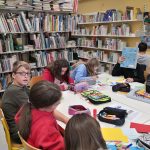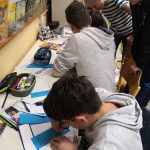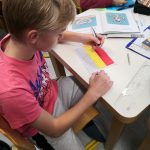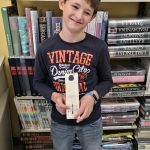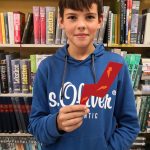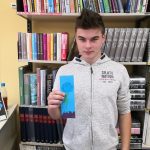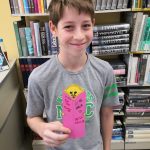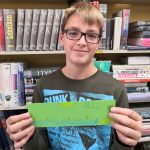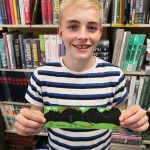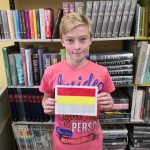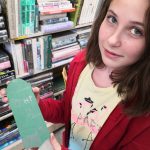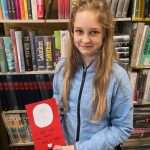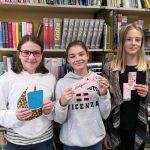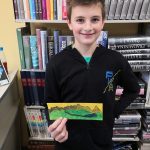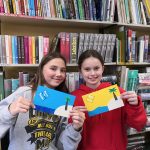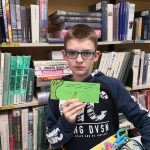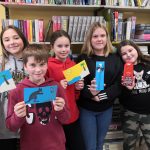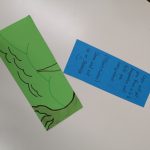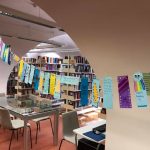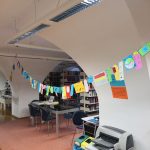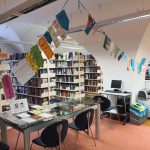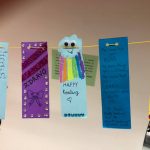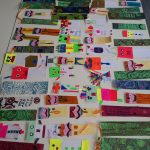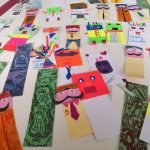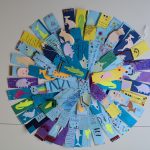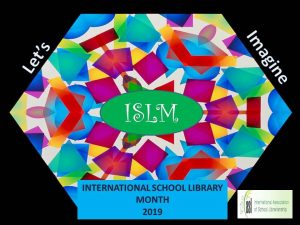
Tema meseca šolskih knjižnic 2019. / The theme of the month of school libraries 2019.
Fourth-graders and seventh-graders along with their mentors are expressing gratitude to both partner schools, i.e. Learning Paths School from Mohali, India and Ivanhoe Girls’ Grammar School from the outskirts of Melbourne, Australia. Our English teacher, David Stegu, wrote the English translation of the article exclusively for you and you can find it below the Slovenian text. Additionally, a comprehensive photo gallery is also available featuring our students from the 7th grade – authors of almost all the bookmarks, which we have sent to Australia. The students of Idrija Primary School wish you all very nice days.
Mednarodni mesec šolskih knjižnic oktober 2019, šolsko leto 2019/2020. Seveda smo se zopet veselo vključili v vsem udeleženim zanimivo izmenjavo knjižnih kazalk, katere organizator je še vedno IASL – International Association of School Librarianship. Letošnja široka tema Let’s Imagine, v prevodu Predstavljajmo si …, je puščala precej proste roke.
Letos smo projekt nekoliko razširili. Prvo leto se je projekta udeležilo okrog 70 učencev. Lani smo bolj pogumno vključili okrog 100 učencev. Tokrat smo število še nekoliko povečali. Pridružilo se je približno 150 učencev. Poleg tega, da nam je sodelovanje ponudila Mestna knjižnica in čitalnica Idrija, je vajeti na Osnovni šoli Idrija v letošnjem šolskem letu prevzela učiteljica v oddelku 4. razreda Tina Strnad Kuduzović. Sodeloval je celoten 4. razred z razredničarkami. Omenjeni so se udeležili izmenjave v mlajši starostni skupini.
V starejši skupini so ponovno sodelovali sedmošolci, saj smo, enako kot leto poprej, projekt strnili v kulturni dan, posvečen še enemu projektu Rastem s knjigo.
Ponovno so nas povezali z Indijo, z Learning Paths School iz mesta Mohali. Z njo so sodelovali četrtošolci. Mohali leži na severu Indije v provinci Punjab. Leta 2011 je tam živelo okrog 175 000 ljudi. Ko vstopimo na spletno stran šole (www.learningpaths.in), nas pričaka triinpol minutni predstavitveni video. V sami špici posnetka so citirali Edwarda Everetta: »Education is a better safeguard of liberty than a standing army.« V slovenskem prevodu to pomeni nekaj podobnega kot: »Izobrazba je boljši zaščitnik svobode kot stoječa vojska.« Čeprav gre za državo, ki je, podobno kot Slovenija s Hrvaško, v nenehnih trenjih s sosednjim Pakistanom, se s citatom ne bi mogli bolj strinjati. V videu se srečamo z različnimi učenci in zaposlenimi, tudi z ravnateljico. Omenijo, da je učno delo prilagojeno vsem trem učnim tipom – kinestetičnemu, slušnemu in vizualnemu. Vse to povzamejo v poimenovanju »Smart Class«. Vsak učenec ima možnost, da se tako ali drugače izrazi. Šola poudarja pogum, predanost, spoštovanje, odličnost, priložnost. Ravnateljica pojasni misijo in vizijo šole – vzgajanje učencev, ki se bodo zmogli soočiti in stati nasproti izzivom vedno spreminjajočega se sveta. Poleg predstavitvenega videa takoj naletimo tudi na fotogalerijo z opombo: Slika je vredna več kot tisoč besed. Preko fotografij spoznamo njihov šolski ambient in različne šolske aktivnosti (robotiko, računalništvo, glasbo, ples, gledališče, šport, likovno umetnost …). Šola, sledi mednarodnim standardom, je z delovanjem pričela 7. aprila 2008. Pod takratnim imenom The Millennium School je vključevala 150 učencev in 16 učiteljev. Leta 2016 se je preimenovala v sedanji naziv. Od samega začetka ji ravnateljuje gospa Komal Singh. Na spletni strani smo našli tudi blog šolske knjižnice. Zanimivo so ga poimenovali kot »A hub of learning« – zvezdišče učenja. Na fotografiji se seznanimo s knjižničarko Seemo Satti – koordinatorko letošnje izmenjave kazalk. V zapisu iz leta 2018 je tedanja izmenjava s kar nekaj tujimi šolami že omenjena. Knjižnica hrani okrog 8500 knjig in 37 naslovov periodike. Odprta je vsak šolski dan od 8. do 16. ure. Zanimiv je podatek, da si zaposleni lahko izposodijo pet knjig za čas enega meseca, učenci pa le dve knjigi za obdobje dveh tednov. Naši četrtošolci so v sklopu pouka likovne umetnosti, na željo omenjene indijske koordinatorke, izdelovali lokalno obarvane stvaritve na temo idrijske rudarske hiše, čipke ter Slovenije. Predhodno so se pri urah družbe seznanili z Indijo in sodelujočo šolo. Za nekatere je bil to prvi »stik« s to oddaljeno deželo. Ugotavljali so podobnosti ter razlike med tujo in domačo šolo. Izdelke so hitro poslali proti Indiji in tudi indijske kazalke so že kar lep čas nazaj prispele do Idrije. Nekatere so bile s tradicionalnimi indijskimi vzorci precej, druge malo manj tipične, vse pa so bile razstavljene v vitrini pred šolsko knjižnico.
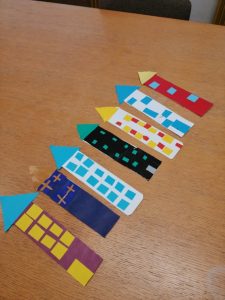
Izdelki četrtošolcev. / 4th graders’ products.
Kot že omenjeno so sedmošolci kazalke za Avstralijo izdelovali v drugem delu kulturnega dneva, posvečenega projektu Rastem s knjigo. V prvem delu so se seznanili z idrijsko splošno knjižnico, prejeli darilno knjigo, se vrnili v šolsko knjižnico, se soočili s principom navajanja knjižnega vira, pomalicali in se nato podali v izmenjavo kazalk. V to smo, kot običajno, vstopili s predstavitvijo sodelujoče države in šole. Avstralija, od nas tako oddaljena, po eni strani precej izolirana, osamljena, drugačna, v svoji naravi ter živalstvu nepopisno lepa. Če smo tedaj preko slikovnega materiala občudovali vse našteto, je bilo žal vse to okrnjeno in prizadeto prav v času, ko so naše in njihove kazalke letele sem in tja. Na našem koncu sveta je bila tedaj zima, na njihovem prevroče poletje z neobvladljivimi požari. Domove, evkaliptuse, koale, kenguruje in še marsikaj drugega so zajeli neusmiljeni ognjeni zublji. Preveč žalostnih podob, ki so nam jih prikazovali mediji in splet, upamo, nikogar ni pustilo ravnodušnega. A še vedno o podnebnih spremembah več ali manj le govorimo, in v dotičnem primeru pišemo, konkretnega pa vsi skupaj storimo bore malo. V knjižnici hranimo knjigo, ki ni ravno v vrhu izposojanih, pod roke smo jo dobili domala po nakjučju. Z naslovom Ali veš, da drevesa govorijo izpostavlja staro modrost Indijancev, ki so z okoljem precej lepše postopali kot postopamo danes. Vsa tako zvana primitivna plemena so znala biti eno z naravo, ki jim je nudila hrano, zatočišče, preživetje. Znala so ji biti hvaležna, se jo po eni strani bati, saj so vedela, kakšna zmore biti, ko pokaže zobe. A danes?! V knjigi najdemo sledeči citat: »Veliko norosti je v vaši takoimenovani civilizaciji. Kot norci drvite beli ljudje za denarjem, dokler ga nimate toliko, da vam ga v prekratkem življenju ne uspe porabiti. Ropate gozdove, zlorabljate zemljo, zapravljate njena bogastva, kot da ste poslednji rod, ne mislite na potomce, ki bodo vse to prav tako potrebovali. Govorite o boljšem svetu jutri, medtem pa gradite bombe, da bi razdejali svet danes.« V Sloveniji poznamo preprost rek, ki na kratko obeta isto usodo: »Kar boš sejal, to boš žel!« Danes Avstralija, jutri pa?
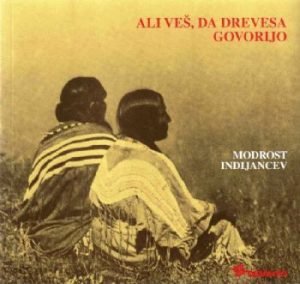
Nalovnica knjige Ali veš, da drevesa govorijo / Do you know, that the trees talk? book cover (vir fotografije: internet)
Pri spoznavanju avstralske sodelujoče šole smo si prav tako pomagali z njihovo spletno stranjo (www.ivanhoegirls.vic.edu.au). Kot pove njeno ime, Ivanhoe Girls’ Grammar School stoji v kraju Ivanhoe, predmestju Melbourna. Ivanhoe, okrog 12 000 prebivalcev ima, je nekako primerljiv z maloštevilčno Idrijo. Veliki 4,5 milijonski Melbourne pač ne. Kot ime šole prav tako pove, gre za dekliško ustanovo. Njen začetek sega v 1903, ko je bila osnovana kot majhna privatna dekliška šola. Danes ima več kot 116-letno zgodovino in sprejme 850 do 1000 učenk od predšolskega do srednješolskega programa. Šola daje prednost razivjanju potencialov deklet, njihovi sreči in uspehu v poznejši odrasli dobi. V personaliziranem načinu dela učenke raziskujejo in nadgrajujejo same sebe z akademskega, socialnega, kulturnega stališča. Poleg običajnega učnega načrta imajo možnost ukvarjanja z različnimi športi, glasbo, gledališčem, debatnimi in drugimi klubi, starejšim učenkam nudijo tudi organizirana potovanja v tujino. Del šolske ustanove je športni objekt z notranjim bazenom, umetnostni center, kjer izvajajo glasbene koncerte, gledališke predstave itd. Knjižnico imajo na voljo za dve starostni stopnji. V navezi smo bili s srednješolsko knjižničarko, koordinatorko izmenjave, Alexio Gibbons.
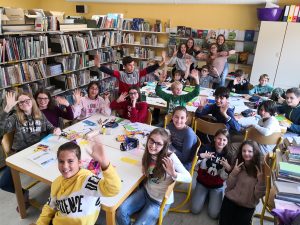
Sedmošolci v knjižnici med izdelovanjem kazalk. / 7th graders in our school library while making the bookmarks.
Naneslo je tako, da so letošnji sedmošolci generacija, ki je nekaj let nazaj izmenjavo na naši šoli otvorila. Takrat, ko še ni bilo delitve na dve starostni skupini, smo sodelovali z Indijsko šolo iz Ahmedabada. Čeprav je bilo sodelovanje prijetno, se je na koncu neljubo primerilo, da nam je partnerska šola poslala skoraj polovico kazalk premalo. Nepriliko smo urejali po svojih močeh, s kopijami originalov. Sodelujoči učenci so rešitev solidno sprejeli. Upali smo, da ne bodo postali nesrečna generacija z dvakratnim zapletom. Kljub zaključku izpred treh let, so se letos radi vključili in pri izdelavi še bolj potrudili. Mogoče so si prav zato poleg avstralskih izdelkov prislužili dodatno darilce. Sodelujoča šola jim je poslala še dva zajetna kupčka kazalk z avstralskima motivoma. Učenci so na »Predstavljajmo si …« mislili svobodno v povezavi s knjigami, branjem, šolskimi knjižnicami ter domišljijo. Lahko so razmišljali v smeri bodočih knjig in knjižnic, njihovi usodi, o svojih ljubih knjižnih junakih, morebiti o sebi kot o takšnem junaku. Ponovno so lahko avstralskim dekletom zapisali sporočilo, misel, citat, se predstavili. Vsi so zapisali svoje ime, starost in šolo. Končni izdelki so bili pričakovano raznovrstni in pisani. Omenili smo ponujeno sodelovanje z Mestno knjižnico in čitalnico Idrija. Dva tedna so bile izdelane kazalke razstavljene pri njih, nato smo jih poslali preko oceanov. Ko smo prejeli avstralske kazalke, smo tudi te za dva tedna postavili v ambient idrijske splošne knjižnice. Da smo tokrat sodelovali z dekliško šolo, je vidno na prvi pogled. Njihove kazalke so polne bleščic in eksotičnih živali. Nekatere duhovite Avstralke so nas z zapisi skušale prepričati, da do šole prijezdijo na kengurujih, a med njimi se je našlo tudi dekle, ki je pošteno namignilo, da gre zgolj za izmišljotino in naj humornim mladenkam nikar ne nasedamo. Po razstavi v mestni knjižnici, je bil čas še za razstavo avstralskih izdelkov v vitrini šolske knjižnice v pritličju šole, kjer so nepričakovano ostale.
Med nastankom, prevodom in objavo članka je minilo nekaj časa. Nedvoumno dovolj, da smo že v kratkem dobili odgovor na »Kdo bo na vrsti jutri?« – vprašanje, zastavljeno višje v prispevku. S pandemijo korona virusa je očitno na vrsti cel svet. Korona nas je v običajnem hitenju uspela malce zaustaviti. Zaustavila je tudi izmenjavo, ki se pri nas tako še ni v celoti odvrtela. Nadejali smo se, da se bo strnila s koncem marca, a se je zgodilo zaprtje šol. Tako še vedno nismo izpeljali žreba, s katerim bi avstralske kazalke dobile nove lastnike, in očitno ga v tem šolskem letu tudi ne bomo. Kazalke bomo shranili na varnem in jih učencem razdelili ob pravem času.
Srečno, trdno voljo in zdravje želimo vsem, da bomo lahko v prihodnje še naprej sodelovali in »krajšali« svetovne razdalje.
The international month of school libraries in October 2019, school year 2019/2020. Of course, we once again gladly took part in the bookmark exchange project, which every participant found interesting and is still organised by IASL – International Association of School Libriarianship. The topic of this year was »Let’s Imagine« and as such it allowed for a rather freehand approach.
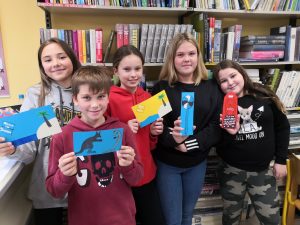
Students of 7th grade with their bookmarks. / Sedmošolci z njihovimi kazalkami.
This time we slightly expanded our project. Approximately 70 students joined the project in the first year. Last year, we took another step forward and included around 100 students whereas this time we increased the number even more. Around 150 students took part. Apart from getting help from the Idrija Public Library, the project at Idrija Primary School was managed by a fourth-grade teacher Tina Strnad Kuduzović. All the fourth-graders took part and were assisted by their class teachers. They participated in the exchange within the junior age group.
The senior age group again consisted of the seventh-graders as we, just like the year before, combined the project with a cultural day dedicated to yet another project called – Growing Up with a Book.
We were again connected with India, with the Learning Paths School from the city of Mohali. Our fourth-graders got involved with that school. Mohali is situated in northern India in the province of Punjab. In 2011 there lived about 175,000 people. When we access their website (www.learningpaths.in), we are first greeted by a short introductory video. In the most crucial part of the video they cite Edward Everett: »Education is a better safeguard of liberty than a standing army.« Despite the fact that it pertains to the country, which is in constant conflicts with the neighboring Pakistan – similar to the situation between Slovenia and Croatia – we could not agree more with the quotation. This video gives us the opportunity to meet different students and employees, including the headmistress. They point out that school work is designed for all three learning types – kinesthetic, auditory and visual. All this is summarised in their concept of a »Smart Class«. All students have the chance to express themselves in their own ways. The school praises courage, dedication, respect, excellence and opportunity. The headmistress explains the mission and vision of the school which is laid upon educating students to know how to accept and face the challenges of the ever-changing world. Apart from the introductory video, we can also immediately see a photo gallery with a meaningful footnote explaining that a photo is worth more than a thousand words. It is by looking at the photos that we get to know their school environment and various activities (robotics, computer science, music, dance, theatre, sport, art, etc.). The school, which adheres to the international standards, was founded in April 2008. Originally named The Millenium School, it included 150 students and 16 teachers. In 2016 it received the name it uses today. Since its very foundation, it has been managed by headmistress Mrs Komal Singh. On the webpage we also found their school library blog. Interestingly they decided to name it as »A hub of learning«. In the photo we encounter the librarian Seema Satti – coordinator of this year’s bookmark exchange project. The text from 2018 already mentions their exchange with some foreign schools. The library itself stores 8,500 books and 37 titles of periodicals. It is open every schoolday from 8 am to 4 pm. One interesting information is that the employees can borrow five books for the duration of one month, whereas students can only borrow two books for the duration of two weeks. As part of the art sessions and based on the wish of the aforementioned Indian coordinator, our fourth-graders produced locally colored artistic creations based on the Idrija Miner’s House, lace and Slovenia. Beforehand, they learned about India and partner school during their Social Science classes. For some, this was the first »contact« with that remote land. They studied both similarities and differences between foreign and domestic school. They quickly sent their bookmarks to India and also the ones from India had actually arrived to Idrija quite some time ago. Some of them were decorated with many traditional Indian patterns and some of them with less but all of them had been showcased in front of the school library.
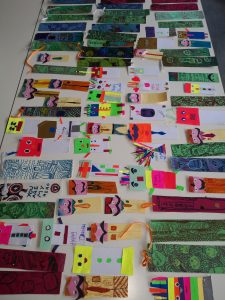
Bookmarks received from India. / Kazalke prejete iz Indije.
As it has already been mentioned, the seventh-graders produced the bookmarks for Australia in the second part of a cultural day, which was dedicated to the project Growing Up with a Book. In the first part they got acquainted with the Idrija Public Library, received a gift book, returned to the school library, learned how to properly cite sources, had a quick snack and then started with the bookmark exchange project. As usually, we first prepared a presentation of the partner country and school. Australia, so far away from us, very isolated, lonely, different and yet so beautiful with its nature and wildlife. While we admired all these beautiful photos during this presentation, unfortunately later on all this was spoiled and broken exactly when the bookmarks – both ours and theirs – were on their way to their respective destinations. In our case, we were in the middle of winter but they had excessively hot summer with uncontrollable fires. Fierce tongues of flame preyed upon homes, eucaliptus trees, koalas, kangaroos and countless other examples of quintessential Australian features. We hope that the countless sad images and video footage left nobody indifferent. However, we still more or less just talk about climate change (or write in this instance) instead of collectively undertaking some concrete measures. We store a book in our library, which is not exactly on top of the list when it comes to borrowing and we actually found it rather as a mere coincidence. The book, which is entitled Ali veš, da drevesa govorijo (Do you know, that the trees talk?), emphasises the ancient wisdom of the Native Americans who used to have a much better relationship with nature as we do today. All the so called primitive tribes knew how to be one with nature, which offered them food, shelter and survival. They knew how to be grateful and were also sometimes afraid of it because they knew how powerful nature could be if it became angry. And today?! In the book we can find the following quotation: »Our so called civilization contains so much foolishness. As maniacs, you white people chase money until you rake in so much that you can’t even spend it in your miserably short life. You’re looting forests, abusing land, wasting its riches as though you were its last generation and you fail to think about your offsprings who are going to need all of this just like you do. You talk about a better world tomorrow and yet in between you are making bombs to destroy the world as it is today.« In Slovenia we have a very simple saying, which roughly foreshadows the same destiny: »You reap whatever you sow.« So, today Australia and who’s next tomorrow?

Bookmarks from Australia. / Kazalke iz Avstralije.
In familiarising with the Australian partner school, we also helped ourselves with their website (www.ivanhoegirls.vic.edu.au). Judging from its name, Ivanhoe Girls’ Grammar School is located in Ivanhoe, the suburb of Melbourne. With around 12,000 residents, Ivanhoe is somehow similar to scarcely populated Idrija. On the contrary, the 4.5 million Melbourne is a totally different story. The name of the school itself also reveals that it is a girls-only institution. Its beginnings date back to 1903 when it was first conceived as a small private girl school. Today, it can pride itself on a 116 year history and accepts between 850 and 1000 students from pre-K to high school program. The school prioritizes the development of potentials of the girls, their happiness and success in the later adult period. As part of a personalized way of work, students explore and upgrade their potentials from the standpoint of academic, social and cultural aspect. In addition to the regular curriculum, they have the opportunity to partake in activities related to sports, music, theatre, debate (and other) clubs and the older students can even participate in organized excursions abroad. One important part of the school institution is also a sport facility with indoor swimming pool and an artistic centre, where they perform concerts and theatrical performances, etc. The library is available for two different age groups. We were in contact with Alexia Gibbons, their high school librarian and exchange coordinator.
It turned out that this year’s seventh-graders are the generation, which initiated the exchange on our school a couple of years ago. Back then, without the existing division on two different age groups, we cooperated with the Indian school from Ahmedabad. Although the cooperation used to be really nice, it did happen at the end that this partner school ended up sending us less than half the number of bookmarks they should have sent. We dealt with this inconvenience to our best abilities by copying the originals. The participating students accepted the solution in a rather understanding way. We were hoping that they would not become the generation which would experience twice such a problem. Despite the unfortunate ending three years ago, they were happy to participate again this year and made even extra effort when it came to the production of the bookmarks. This might have been the reason why they received a small gift in addition to the Australian bookmarks. The partner school sent them two additional piles of bookmarks with Australian motifs. Students were given the task to think (in relation to the theme of »Let’s imagine…) freely about books, reading, school libraries and imagination. They could think about the future books and libraries, their destiny, their own literary heroes or perhaps about themselves as being some of such heroes. Once again they were able to write to the Australian girls either a message, a thought, a quotation or perhaps a presentation about themselves. All of them wrote their name, age and school. The final products were truly diverse and colourful. We have mentioned the cooperation with the Idrija Public Library. They had the bookmarks showcased for two weeks and then we sent them across the oceans. Upon receiving Australian bookmarks, we showcased these for two weeks at the Idrija Public Library. It is quite obvious that we cooperated with a girl school this time. Their bookmarks are scattered with glitter and abundant with exotic animals. Certain texts were quite funny as some Australians tried to persude us that they ride kangaroos on their way to school but one girl wrote with care that this was all made up and that we should not fall for the texts which had been written by other girls. After the exhibition at the Idrija Public Library, we also showcased Australian bookmarks on the ground floor of the school where they have unexpectedly remained up to this day.
During the writing, translation and publication of the article passed quite some time. It has undoubtedly been enough for us to figure out the answer to the question »Who’s next tomorrow?« -the question posed earlier in this article. Because of the coronavirus pandemics it is apparently everybody’s turn now. Corona has managed to slow us down in our daily haste. It has also halted the exchange, which has not entirely finished in our case. We hoped it would finish by the end of March but then came the school closure. For this reason we still have not conducted the draw by which we would have determined the new owners for the Australian bookmarks and apparently we will not be able to do that this school year. We are going to keep the bookmarks in a safe place and when the time comes, we are going to distribute them to the students.
We wish happiness, strong will and health to all of you so that we may keep on cooperating in the future and contribute to the »shortening« of global distances.
David Stegu, Tina Strnad Kuduzović, Martina Vidmar
- Kazalke, ki so jih izdelali naši četrtošolci. / The bookmarks made by our 4th graders.
- Več izdelkov četrtošolcev. / More products by our 4th grade.
- 7. a v knjižnici med izdelovanjem kazalk. / 7. a class in our school library while making the bookmarks.
- Lena pri izdelovanju. / Lena making her bookmark.
- Kot si Miha predstavlja knjižno bodočnost. / As Miha imagines the book future.
- Nastaja Borutova kazalka. / Borut’s bookmark in process.
- Učenec Urban. / Student Urban.
- 7. c v knjižnici. / 7. c class in library.
- Jakob s svojo kazalko. / Jakob and his bookmark.
- Žana ustvarja. / Žana creating.
- Nasmejani Florijan. / Smiling Florijan.
- Učenka Leonisa. / Student Leonisa.
- Tadejeva kazalka. /Tadej’s bookmark.
- Pozdravljajoči Matic. / Matic saying hi.
- Eneja in Anika. / Eneja and Anika.
- Rok.
- Seid s svojo kazalko. / Seid with his bookmark.
- Ažbetov izdelek. / A bookmark by Ažbe.
- Stella in Lana. / Stella and Lana.
- Sedmošolec Nace. / Nace from 7th grade.
- Manca. / Manca.
- Mančina dvojčica Neža. / Manca’s twin sister Neža.
- Še ena Neža. / Another Neža.
- Gal z modrim izdelkom. / Gal and his blue product.
- Anja.
- Učenka Sofija. / Student Sofija.
- Tjan.
- Hana.
- 7. b razred. / 7th b class.
- Kreativni proces. / Creative process.
- Filip s končano kazalko. / Filip with his finished bookmark.
- Učenec Klemen. / Student Klemen.
- Nejc in njegova kazalka. / Nejc and his bookmark.
- Tjan.
- Elhan.
- Matevž.
- Adam in idrijska zastava. / Adam and created Idrija flag.
- Kaja Rebeka s kazalko o Harryju Potterju. / Kaja Rebeka with a bookmark made on Harry Potter theme.
- Lana.
- Alja, Ivana Rosa in Neža. / Alja, Ivana Rosa and Neža.
- Luka.
- Učenec Vid. / Student Vid.
- Tija in Tara. / Tija and Tara.
- Elmin.
- Kreativna Živa. / Creative Živa.
- Luka.
- Students of 7th grade with their bookmarks. / Sedmošolci z njihovimi kazalkami.
- Razstava kazalk sedmošolcev v Mestni knjižnici in čitalnici Idrija. / In Idrija Public Library exhibited bookmarks of our 7th graders.
- Bookmarks received from India. / Kazalke prejete iz Indije.
- Bookmarks from Australia. / Kazalke iz Avstralije.

